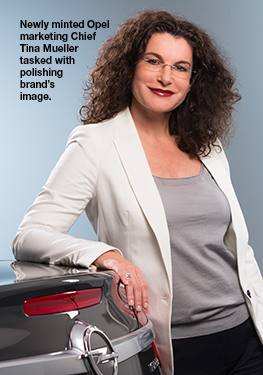GENEVA – General Motors soon may begin selling inexpensive, entry-level Opel models in Europe, a shift in strategy aimed at resuscitating a struggling brand that has failed in a bid to move up-market.
“If we see a customer need we are able to meet within the bandwidth of the Opel brand in a particular segment, we will move on it,” GM President and Opel Chairman Dan Ammann tells journalists during an interview here.
“We’re prepared to respond to where the market wants us to go,” he says.
Tina Mueller, Opel’s new marketing chief in Europe, echoes those sentiments, saying the brand lacks focus in the sub-€10,000 ($14,000) segment. Its least expensive model, the 1-year-old Opel Adam city car, sells for anywhere between €12,000 and €16,000 ($16,000-$22,000).
“We see a need below €10,000, because we know for the younger generation (cars) are less and less affordable,” Mueller says.
Playing at the low end of the market would be a shift in strategy for Opel. As recently as last year, the plan was to push the brand up-market as a more expensive alternative to the value-oriented Chevrolet marque. But in December GM chose to pull the plug on Chevrolet as a mainstream brand in the region, an uneven rollout dating back to 2005.
“It creates more breathing space for Opel,” Ammann says. “It creates more clarity, more simplicity, and as part of that you end up with some bandwidth within which to operate.”
The greater bandwidth, however, does not mean Opel will pursue the luxury end of the business anytime soon to compete against top names Mercedes, BMW and Audi.
Opel’s most expensive model, the Insignia D-car, starts at about €25,000 ($35,000).
“Opel needs to be a democratic brand,” says Mueller, 45, a native German who joined the automaker Aug. 1 from the consumer products and auto-parts supplier Henkel.
“Given the recent history of Opel, we need to concentrate on our core segments, which are small, midsize and compact (vehicles) before we enter into luxury. I’m a fan of doing your homework first and getting the brand back, because today (Opel) would not support a BMW buyer. It is too early.”
For many years, Opel and Volkswagen slugged it out as the populist brand in Germany and other European markets. But 14 years of financial losses put Opel’s product offerings on the ropes. Last year, the brand sold 738,411 units in Europe, according to WardsAuto data. Volkswagen delivered 2.1 million.
To stop the slide, GM will invest €4.0 billion ($5.2 billion) over three years in Opel and its U.K. sister brand Vauxhall. The outlay will produce 23 new products and 13 fresh powertrains, including at the auto show here an Adam Rocks version of the Opel Adam with a new 1.0L turbocharged 3-cyl. engine and 6-speed manual transmission, giving the small car a more competitive powertrain in the segment.
Opel also shows an even racier Adam S and the high-performance Opel Astra OPC Extreme C-car with a next-generation 1.6L CDTI diesel engine. In addition, Opel reveals plans to launch OnStar connectivity in Europe next year with 4G LTE high-speed wireless Internet connectivity.
Signs of Progress
Strides have been made already, Ammann says. The Opel Adam and Mokka small CUV, for example, helped Opel post a market-share gain to 5.61% last year from 5.59% in 2012, according to the automaker. It was the first market-share gain for Opel in 14 years.
“A small, but important milestone,” Ammann says. “There’s no doubt we’re making some real progress.”
On the financial side, Opel slashed its losses in Europe to $800 million last year from $1.9 billion in like-2012. It also has appointed a slew of new executives in recent months, such as Mueller and CEO Karl-Thomas Neumann, and added a captive financing unit to support sales.
 The investment puts muscle behind an unprecedented marketing campaign to polish Opel’s image, too, which Mueller admits had grown “dusty, old-fashioned” and slipped into irrelevance. She says early progress is being made there, as well, with poster, Internet and television campaigns reminding consumers of its German engineering and portraying cars such as the funky little Adam in a more progressive light.
The investment puts muscle behind an unprecedented marketing campaign to polish Opel’s image, too, which Mueller admits had grown “dusty, old-fashioned” and slipped into irrelevance. She says early progress is being made there, as well, with poster, Internet and television campaigns reminding consumers of its German engineering and portraying cars such as the funky little Adam in a more progressive light.
“Since October of last year, we see the image is catching up significantly, month by month,” Mueller says. “The brand position is changing, and I believe with this image campaign we can provoke people to look at Opel in a different way.”
She says reminding Europeans that Opel is a German brand conveys a higher quality standard. “We are not known for fashion or furniture design. We are known for cars.”
Mueller expects the Opel brand to be back on track in terms of consumer perception by 2016. Although the early success gives her reason to think it may come sooner, Mueller still places Opel’s comeback in the context of David vs. Goliath.
“We have to be faster and more daring,” she says.
That’s why Mueller took the assignment in the middle of a successful 20-year career in cosmetics.
“If I manage to turn this brand around and get it back on stage, that’s the best you can do as a marketing person,” she says.





